Garden Planting Guide
Choosing Seed Varieties
Part of the enjoyment of planning your garden is choosing which seed varieties you want to grow. Choosing varieties that work best for your growing conditions and take advantage of your environment will ultimately decide the outcome of your growing experience. Below are a few tips when selecting your vegetable, herb and flower seeds.
Vegetables:
Selecting your veggies before you design your garden will help ensure that you have the correct amount of room and the best growing conditions. For smaller gardens, choose bush varieties that take up less room. For shorter growing seasons, try fast maturing varieties that can produce maximum yields for your growing season.
Herbs:
Choose herbs by size, growing habits and life expectancy. Many herbs can live as perennials and will increase in size every season thus needing adequate space to grow and receive the proper nutrition.
Flowers:
Flowers can reward gardens with beauty and high pollination rates. Mixing flowers in with your vegetable garden will increase yield potentials. Also, choosing between annuals and perennials can be hard. Annuals can be easily removed and replaced the next season, while perennials will come back every season. Plus, many flower seeds are hard to germinate and require an adequate amount of care and time to grow correctly.
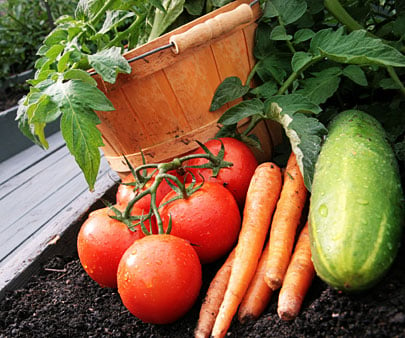
Planning
Planning is the key to success for any garden or landscaping that you plan to grow this season. Choosing a plant’s location, spacing, and feeding option is important in the success of your gardening season. Always be on the safe side when you garden, so never bite off more than you can chew! Grow a smaller garden, one that can be taken care of if time is scarce.
Always leave enough space between vegetables, herbs and flowers in order for them to breathe correctly and receive proper nutrition. Choose varieties that are correct for your growing conditions. Perennials cannot survive in certain locations so know your hardiness zone and choose perennials accordingly.
For vegetables, plan your yields according to family size and whether you will need to freeze, can or practice successive gardening in order to have fresh crops every couple weeks.
Sowing
Most soil mixes consisting of peat, perlite and vermiculite are excellent seed sowing media for bedding plants. Besides light and moisture, seeds need warmth to germinate well. A soil temperature of 70°F is sufficient for most crops. Please see the planting depth of most seeds for optimal conditions. Some seeds prefer growing just below the soil including most vegetables, herbs and flowers. Although some flower seeds need light to germinate and should be placed on top of soil.
Transplanting
After the seeds have germinated, let the surface dry out occasionally. Seedlings should never go through the night with wet leaves. Grow them at proper temperatures as given in this guide for fast, yet sturdy plants. When seedlings have developed their first set of true leaves, they are ready to be transplanted to a 4” inch pot for optimal growing conditions.
Many ingredients can be used, to prepare a good growing medium for bedding plants. Most commonly used are 2 parts soil, 1 part peat moss and 1 part sand with fertilizer added. Mist the young plants frequently during the first week of transplant until they are well established, then water more thoroughly and less often. Keep your seedlings growing fast with the recommended liquid feeding program.
Some vegetables are recommended for direct sowing such as beans, peas, corn, carrots, radish, pumpkins, cucumbers and others. Some varieties do much better by starting inside such as tomatoes, peppers and herbs. These seeds don’t require much attention just a regular watering and should be hardened's before transplanting outside.
Vegetable Planting Tips
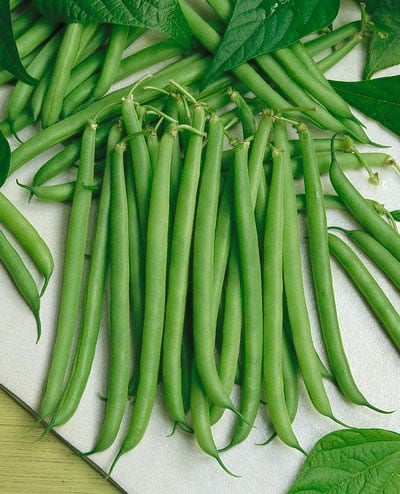
Bean Tips
Beans should be directly sowed into your garden, not grown as a transplant. Be sure not to plant bean seeds too early as they may rot due to cold weather and moist soil. If you insist on starting early, place a black tarp over the soil to warm its temperature. For Bush bean varieties, try a continual planting schedule by sowing a seed every couple weeks which should give you a consistent harvest. Plant bush seeds every 12-18 inches and be sure to water consistently until germination occurs, then regularly every few days. For pole varieties, they will need some time to grow their vines but will produce continuous harvest for a couple months. Pole beans need some type of support so be sure to have a trellis or fence ready before planting. Plant seeds every 4 inches and supply moist soil. Add fertilizer half way through their growing season.
Learn More: How to Grow Beans
Suggest Varieties:
Topcrop – A great bean for canning and freezing.
Slenderette – One of the best tasting beans for home gardeners.
Contender – A very productive bean that needs little care.
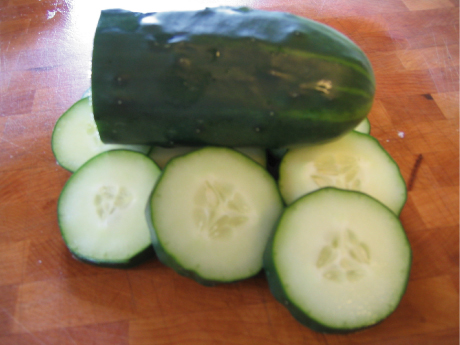
Cucumber Tips
Cucumbers require full sun and a large amount of space in order to develop properly. If space is limited, there are some varieties available that can grow in small spaces and containers, like the Spacemaster. Cucumbers should be directly sowed into your garden, but can be transplanted at three weeks old and after the last spring frost. Be sure to plant after last frost as any freezing temperatures can kill your plants. In general, cucumbers can grow in most soils but prefer a pH of around 6.0 to 6.5. Be sure to add a generous amount of organic compost to your soil before planting your cucumber seeds. This will ensure proper nutrition and produce strong vigorous plants with heavy yields. To maximize growth, try applying a minimal amount of fertilizer when needed. A good way to reduce weeding and increase soil moisture is to apply some type of mulch or wood chips to your garden.
Learn More: How to Grow Cucumbers
Suggested Varieties:
Spacemaster – A great compact variety for containers or small gardens.
Homemade Pickles – A very popular pickling cucumber for home gardeners.
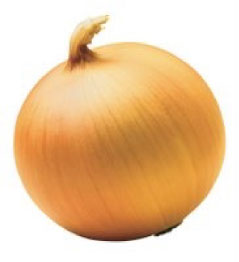
Onion Tips
Onions can be a tricky vegetable to grow. The most important aspect to remember about onions is there are three different categories: long-day, short-day and Intermediate onions. Long-day onions will grow best in northern states while short-day varieties do well in southern states. Intermediate onions will do well in both northern and southern states. Short-day onions develop bulbs with an average of 12 hours of daylight. Long-day onions develop better with more sun, around 15-16 hours of daylight. To ensure proper maturation, be sure to grow the variety of onion that is suited for your location. Onion seeds can be started both indoor and outdoors, but for best results seedlings should be started indoors. When ready to transplant, place onions 3 to 4 inches apart, in rows divided by 15 inches. Onions grow best in rich soft soil, but can grow well in most soils especially with a nitrate-based fertilizer. Keep the soil moist and allow good drainage.
Learn More: How to Grow Onions
Suggested Varieties:
Sweet White Walla – A mild onion that can even be eaten like an apple.
White Spanish – A standard large onion with a sweet taste.
Yellow Spanish – One of the most popular onions for home gardeners.
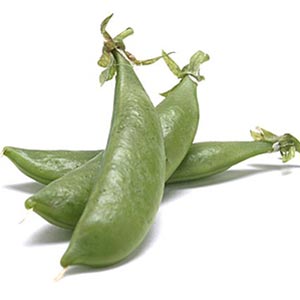
Pea Tips
Peas are a hardy crop that can provide an abundant harvest in a limited amount of space. There are four main varieties of peas that are grown in the home garden: Garden peas, Snap peas, Snow peas and Cowpeas. Garden peas (English peas) have a hard outer shell and must be removed. Snap peas have low-fiber pods that are snapped and eaten before the seeds mature. Snow or Sugar peas should be eaten whole with both pod and seeds. Lastly, Cowpeas are shelling peas with an excellent flavor. Pea seeds should be directly sowed into your garden in early spring four to six weeks before the last spring frost. When the seeds begin to germinate, they will need a trellis or staking to provide the necessary support. In order to extend harvesting and yield try sowing seeds every week. Peas plants should be spaced every 5 inches. Peas are heavy feeders and will do best with the occasional fertilizer, but too much fertilizer can increase foliage and decrease pea yield. Lastly, keep the soil moist and harvest mature pods to keep plant productive.
Learn More: How to Grow Peas
Suggested Varieties:
Super Sugar – The original tall snap pea that has an improved sweet flavor.
Oregon Giant – A home garden favorite with an excellent yield potential.
Little Marvel – A high yielding pea with an excellent sweet taste..
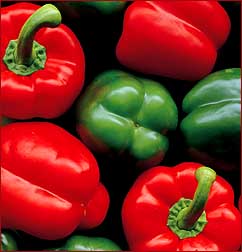
Pepper Tips
Peppers come in a variety of shapes and sizes as well as a varying degree of sweet to very hot. Today’s gardeners enjoy a large selection of home garden peppers; green bell peppers by far being the most popular choice. Peppers can be sowed both indoor and outdoor, but for best results we recommend starting pepper seeds indoors, 12 weeks or more before the last frost date for your location. Pepper seeds are difficult to germinate and seedlings tend also grow slow. One way to increase seed germination is to provide a bottom heat to your soil raising it to 80 degrees. This will increase higher and quicker seed germination. When transplanting your pepper plants, space 18-24 inches apart and 24 inches between rows. Select a location that receives full sun an add plenty of fertilizer to the garden soil. Keep soil moist but not wet.
Learn More: How to Grow Peppers
Suggested Varieties:
California Wonder – A garden staple that is easy to grow with a delicious flavor.
Early Jalapeno – An early maturing, low-range hot pepper.
Cayenne Long Red – A col-md-hot pepper with an excellent tangy kick.
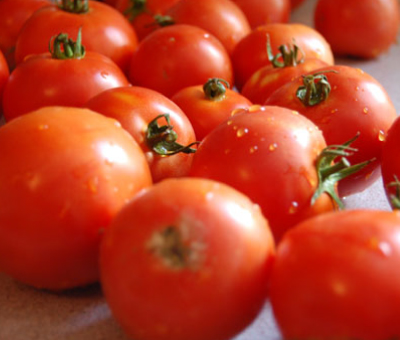
Tomato Tips
Tomatoes are by far the most popular vegetable in home gardens being grown in over 85% of them. There are many different types including beefsteak, cherry, paste, mid-size, early ripening and the list goes on. Tomato seeds should be started indoors for best germination results. Start the seeds indoors six to eight weeks before the last frost date for your location. Plant 1/4 inch deep using sterile soil. This helps prevent disease and other problems. The tomato seeds will germinate best if the soil is kept between 80 to 90 degrees. Water lightly and keep the soil consistently moist until germination occurs. When ready to transplant, be sure to harden the young plants off by placing increasing time outside for a 1 week period. Transplant tomato plants 32 inches apart and 32 inches between rows, the more space the better. Plant in a location with full sun and provide fertilizer when needed.
Learn More: How to Grow Tomatoes
Suggested Varieties:
Brandywine – A popular home garden tomato with a great flavor.
Sweetie – A cherry tomato that is a prolific producer.
Cherokee Purple – A favorite for its taste, unique color, and high yields.
| Variety | Planting Depth | Sowing Date | Days to Germination | Soil Temperature (℉) | Plants (inches) | Rows (inches) | Days to Maturity | Family of Four (typical growing season) | Seeds per oz. | Seeds per 100 foot row |
|---|---|---|---|---|---|---|---|---|---|---|
| Asparagus | 4 | January-February | 10 | 75 | 14 | 28 | 720+ | 40 plants | 750 | 1 oz. |
| Bean Bush | 1.5 | May-June | 7 | 80 | 18 | 18 | 50+ | 25 foot row | 100 | .5 lb. |
| Bean Vine | 1.5 | May-June | 7 | 80 | 4 | 30 | 70+ | 25 foot row | 100 | .5 lb. |
| Beets | .5 | March-July | 4 | 85 | 4 | 18 | 40+ | 15 foot row | 1,500 | 1 oz. |
| Broccoli | 1 | April-June | 4 | 80 | 24 | 30 | 70+ | 15 foot row | 9,000 | .25 oz. |
| Cabbage | .5 | April-May | 4 | 85 | 24 | 30 | 100+ | 15 plants | 8,500 | .25 oz. |
| Carrots | .5 | January-August | 6 | 80 | 3 | 18 | 65+ | 30 foot row | 25,000 | .5 oz. |
| Cauliflower | .5 | January-June | 5 | 80 | 15 | 28 | 60+ | 15 plants | 10,000 | .25 oz. |
| Corn | 1 | April-May | 5 | 95 | 3 | 24 | 60+ | 75 plants | 75 | .4 lb. |
| Cucumbers | 1 | April-July | 3 | 95 | 36 | 40 | 50+ | 6 plants | 1,000 | .5 oz. |
| Eggplants | .5 | April-June | 6 | 85 | 24 | 36 | 80+ | 6 plants | 6,000 | 50 plants |
| Gourds | .5 | April-May | 10 | 80 | 48 | 60 | 100+ | varies | 1,000 | .25 oz. |
| Kale | .25 | May-July | 4 | 80 | 18 | 24 | 55+ | 20 foot row | 8,700 | .25 oz. |
| Leeks | .25 | March-May | 7 | 80 | 6 | 24 | 120+ | 10 foot row | 11,000 | .5 oz. |
| Lettuce | .25 | February-October | 3 | 75 | 10 | 20 | 55+ | 15 foot row | 25,000 | .25 oz. |
| Melon | 1 | March-April | 4 | 80 | 36 | 36 | 85+ | varies | 1,000 | .5 oz. |
| Mustard Greens | .25 | April-September | 8 | 75 | 6 | 12 | 35+ | 10 foot row | 15,000 | .25 oz. |
| Okra | 1.5 | April-September | 6 | 95 | 18 | 36 | 55+ | 15 foot row | 500 | 2 oz. |
| Onions | .5 | February-April | 6 | 75 | 3 | 15 | 90+ | 40 foot row | 8,000 | 1 oz. |
| Peas | 1.5 | March-June | 6 | 75 | 5 | 36 | 60+ | 40 foot row | 120 | 1 lb. |
| Peppers | .5 | January-May | 8 | 85 | 24 | 24 | 75+ | 10 plants | 4,500 | 50 plants |
| Pumpkins | 3 | April-June | 4 | 90 | 6 | 36 | 90+ | 3 plants | 180 | .5 oz. |
| Radishes | .5 | March-August | 4 | 85 | 2 | 20 | 30+ | 4 foot row | 2,500 | 1 oz. |
| Spinach | .5 | March-July | 5 | 70 | 6 | 16 | 45+ | 20 foot row | 2,800 | 1 oz. |
| Squash | 1 | March-April | 4 | 95 | 36 | 36 | 65+ | 3 plants | 250 | .75 oz. |
| Strawberries | .125 | December-February | 10 | 80 | 18 | 36 | 120+ | 2 plants | 70,000 | 1 gram |
| Tomatoes | .5 | January-May | 6 | 85 | 32 | 32 | 70+ | 15 plants | 11,000 | 50 plants |
| Turnips | 1.5 | March-August | 3 | 85 | 3 | 24 | 45+ | 15 foot row | 15,000 | .5 oz. |
| Watermelon | 1 | March-April | 4 | 95 | 72 | 72 | 110+ | 6 plants | 350 | .75 oz. |
Herb Planting Tips
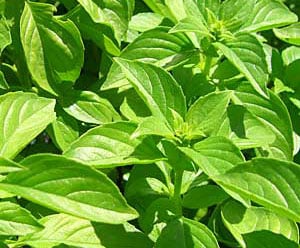
Basil Tips
There are many different kinds of basil to choose from for today’s gardeners. They range from cinnamon, lemon, to purple basil that is used mostly for decoration. Choose a variety right for you and your needs, as basil is only an annual and will have to be replanted every year. Basil can be grown indoors with the right conditions, but is most often started indoors and then transplanted outdoors. Start your basil seeds indoors 6-8 weeks before last frost for your location. Drop a few seeds into each cell to ensure germination. Cover the seeds with a slight soil cover and dampen soil with a light watering. To speed up germination cover with a plastic top and place in a sunny location. Water twice a day and remove plastic top when seedlings emerge. Once two sets of leaves emerge, basil can be transplanted into the garden. Pinch off the top two sets of leaves once the basil plant reaches reasonable height. This gives you a much higher quality plant.
Learn More: How to Grow Basil
Suggest Varieties:
Italian – The most popular basil variety with a tangy flavor.
Lemon – An aromatic basil with a great lemon flavor.
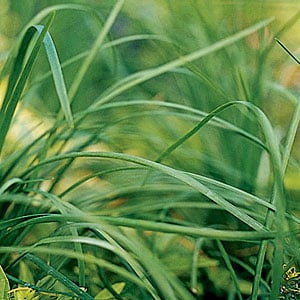
Chive Tip
Chives are by far the easiest herb to grow in the home garden. They can be easily started by seed indoors or outdoors. Plant chive seeds about 1/4 inch deep in wet soil. Chive seeds will germinate best indoors in a dark spot until they begin to sprout. Then move to a location where they get some sun. Chives do well in soil temperatures 60-70 degrees. When the chives reach 6” tall they are ready to be transplanted to the garden. Find a location that has strong sunlight and rich soil, but will survive and almost any area. If you decide to directly sow chive seeds into the garden be sure to wait till after the last frost. The seeds may be slow to germinate until the soil warms up. Harvesting chives is just as easy as growing them. Once they reach 1 foot tall, they are ready to be used. Cut offas much as you need. It is safe to cut off as much as half of the chive without harming the plant. The flowers the chives produce are edible as well and can be added to your salad or decoration of many meals.
Learn More: How to Grow Chives
Suggested Varieties:
Common Chive – A chive that has an excellent onion flavor.
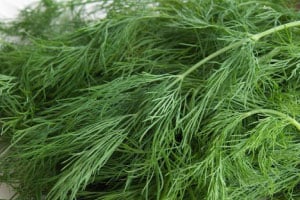
Dill Tips
Dill is a tall, hardy herb plant that will grow as an annual in most locations. Dill is grown for both its leaves and seeds which can be used in many ways and is also one of the easier herbs to grow indoors and outdoors. Dill can easily be grown in a container garden. When growing outdoors, it is important to take two things into consideration. It grows tall so be sure to plant in a location that will not block other plants from receiving an adequate amount of sun. Since it grows tall, it can be damaged by high winds so try to find a location that blocks the wind. Plant dill directly where it will stay as it germinates quickly. Find a location that has plenty of sun. Cover the seed with 1/4 inch of soil and water soil generously. For best results, the soil needs to be cultivated deep in order for the dill roots to strengthen properly. Plant seeds in the spring after your last frost date. To ensure a long harvest try planting seeds every few weeks.
Learn More: How to Grow Dill
Suggested Varieties:
Mammoth Long Island – The original dill plant that produces high essential oils.
Bouquet – An easy to grow dill withflavorful and unique foliage.
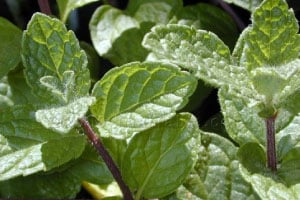
Mint Tips
Mint is another easy herb to grow and is perfect for the beginning gardener or anyone that loves the mint flavor. Mint grows very quickly and is a hardy perennial that can grow to over 3 feet in height. We suggest starting mint indoors with controlled conditions. Sow mint seeds 1/4 inch deep and cover with loose, moist soil. For best germination rates, keep soil above 70 degrees. When the transplants are a reasonable size and have been hardened off from the outside conditions bring them outside and plant anywhere from 12-24 inches apart depending on the variety requirements. Choose a location that has full to partial sun and mint will do well in almost any soil conditions. Mint leaves can be harvested at any times once that plant has established itself in your home garden. Try picking them in the morning hours when the oils tend to be strongest. Spread leaves out and dry in a cool, ventilated area.
Learn More: How to Grow Mint
Suggested Varieties:
Spearmint – A variety with a great scent used in sauces, teas, jellies, and sweets.
Peppermint – A variety used for teas andflavoring peppermint candies.
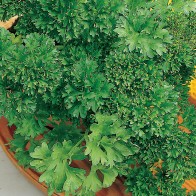
Parsley Tips
Parsley tends to grow best in the northern states of the country, but can be grown almost anywhere with the right care and location. Parsley can add beauty and taste to many meals. Parsley seeds are on the harder side to germinate when compared to most herb seeds. One of the best methods to increase germination is to soak your parsley seeds in warm water overnight. Be sure to change the water frequently, every 2 hours, as a growth inhibitor is released by the seeds! Sow the seeds in a seed starting medium and cover with 1/4 inch of soil. Keep the soil evenly moist and seeds will do best with a soil temperature of 70 degrees. Seed germination can take up to 14 days so be patient. Transplant seedlings when they are 6 inches in height and after your last frost date. Be sure to loosen soil deep into ground for health parsley plants. Depending on variety, but in general space plants 6-8 inches apart. Try protecting your parsley over the winter and it may reseed itself.
Learn More: How to Grow Parsley
Suggested Varieties:
Italian Leaf – A flat, dark leaved variety with a pronounced flavor.
Krausa – A dense, beautiful dark green parsley that grows on strong stalks.

Sage Tips
Sage is a rewarding herb to grow as it can add some taste to any meal. Sage is an easy herb to grow from seed but can require some patience as sage seeds are slow germinators. Sage can be started indoors or outdoors, but as always we recommend starting inside for better germination rates. Spread sage seeds over soil and cover with 1/8 inch of damp soil, but not soaked. Not all seeds will germinate and the ones that do may take up to 6 weeks so patience is key! When your Sage seeds have become seedlings and are ready to transplant into your home garden be sure to harden them o to the outside conditions. Sage plants prefer full sun and do best in well drained soils as they prefer to not have their roots remain wet. Allow for the soil to dry between waterings. Sage comes from hot, dry climates and will do best in southern states, but can be grown anywhere. Harvest biggest leaves first and pruning the top leaves early will entice a fuller, better producing Sage plant.
Learn More: How to Grow Sage
Suggested Varieties:
Common – A great herb for many dishes that include meat.
| Variety | Planting Depth | Indoor Date | Outdoor Date | Soil Temperature (℉) | Height (inches) | Spread (inches) | Days to Maturity | Soil | Light | Growth Type |
|---|---|---|---|---|---|---|---|---|---|---|
| Basil | 1/2 inch | Anytime | March-August | 70 | 12-24 | 12 | 70 | Rich and moist | Full | Annual |
| Catnip | 1/4 inch | Start 4-8 weeks before the last frost | April-June | 70 | 12-36 | 18 | 75 | Rich | Full | Perennial |
| Chives | 3/8 inch | Anytime | April-May | 65 | 12-18 | 18 | 80 | Rich and moist | Full | Perennial |
| Coriander | 3/8 inch | Start 2 weeks before the last frost | March-August | 60 | 12-36 | 4 | 65 | Light | Partial | Annual |
| Dill | 3/8 inch | Start October-April | March-August | 65 | 36-48 | 12 | 60 | Rich | Full | Annual |
| Lavender | 1/2 inch | Anytime | April-May or October | 70 | 18-36 | 24 | 2 years | Well drained | Full | Perennial |
| Lemongrass | 3/8 inch | Start February-March | March-August | 70 | 12-24 | 18 | 75 | Rich | Partial | Annual |
| Mint | 1/8 inch | Anytime | April-May | 70 | 12-24 | 18 | N/A | Rich and moist | Partial | Perennial |
| Oregano | 1/4 inch | Anytime | April-May | 70 | 12-24 | 18 | 85 | Poor | Full | Perennial |
| Parsley | 3/8 inch | Anytime | March-August | 70 | 18-24 | 6-8 | 80 | Rich | Partial | Biennial |
| Rosemary | 1/8 inch | Anytime | April-May | 70 | 48-72 | 48 | 85 | Less acidic | Full | Perennial |
| Sage | 1/8 inch | Anytime | April-May | 60 | 12-48 | 30 | 70 | Well drained | Full | Perennial |
| Stevia | 1/8 inch | Start February-March | April-May | 65 | 18-30 | 20 | 100 | Rich | Full | Perennial |
| Thyme | 1/4 inch | Anytime | April-May | 70 | 6-24 | 10 | 80 | Fertile | Partial | Perennial |
Flower Planting Tips
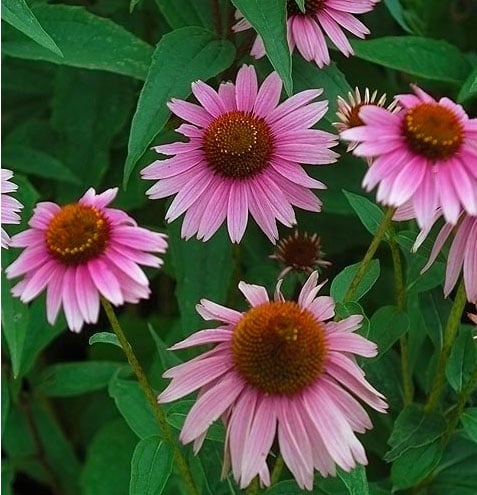
Coneflower Tips
Coneflowers are some of the easiest and most rewarding flowers you can grow. They attract birds and butterflies and can be cut and brought inside where they last a long time. Coneflowers should be directly sowed outside into your flower garden. Spread your seeds 12-18 inches apart to give adequate space to fully grow. Cover seeds with 1/4 inch of moist garden soil. Coneflowers do well in almost any soil and tolerate dry soil conditions very well. Be sure to water them during really dry periods to keep growing healthy. Coneflowers will do well when given a fertilizer once or twice a season. Coneflowers will grow to 24 to 42 inches tall and will form many branches. To encourage new blooms, try cutting off all the dead blooms. Coneflowers are a very hardy flower and will survive the first light frost. Coneflowers reseed themselves and come back every year.
Learn More: How to Grow Coneflowers
Suggested Varieties: Purple – A sturdy perennial with beautiful blooms that will reseed itself. White Swan – A variety with pure white petals and an orange-brown disk. Yellow – A beautiful conedflower that has bright yellow petals.
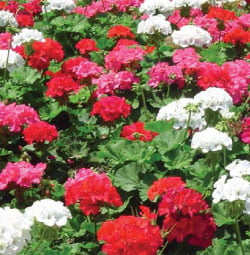
Geranium Tips
Geraniums are slow to germinate from seed, so be sure to start your seeds well ahead of your blooming expectations which could take 14-16 weeks from initial sowing. In order to increase germination rates, it helps to soak before sowing. A good method for geraniums is to dampen a few paper towels and fold over your geranium seeds. Place in a zip-lock bag and let sit for 24 hours. Plant a few seeds per pot in high quality soil at a depth of 1/2 inch. Geranium seeds do not need light to germinate and should have a constant soil temperature of 70-75 degrees. To ensure adequate moisture be sure to cover pots with plastic until you notice green sprouts. When they begin to sprout, open plastic to vent and place in good sunlight. Once two true leaves appear (the first leaves are seed leaves), remove from the plastic cover. Allow seedling to grow for a couple weeks and then transplant each seedling into its own pot. Keep soil moist and supply 12 hours of sunlight a day. Pinch off the top of plant once it’s growing strongly. This will promote branching and full growth.
Learn More: How to Grow Geraniums
Suggested Varieties:
Mix Maverick – A true pack-blooming geraniums with rounded heads.
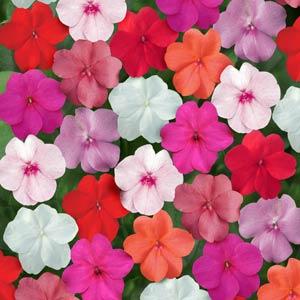
Impatien Tips
Growing Impatiens yourself is a great money saver and fun experience. The ideal time to plant your Impatien seeds is 10-12 weeks before the last frost date of your location. Fill your pots with sterile seed starting mix and wet the soil. Place two seeds in each pot and cover with 1/8 inch of soil. Once the seeds have been planted it is important to cover the pots with plastic bags to keep the moisture in. Impatiens need grow lights or indirect light from a window. The soil temperature should be 70-75 degrees for maximum germination. Impatiens can sprout in as little as 7 days but can take as long as two weeks. If the temperatures are cooler it could even take longer. Be sure to remove plastic wrap as soon as the seedlings germinate. Impatiens are susceptible to fungal disease so be sure not to over water. When plants are adequate size they can be transplanted into your flower garden. Wait until all danger of the last frost has passed and be sure to harden the Impatien plants before transplanting.
Learn More: How to Grow Impatiens
Suggested Varieties:
Super Elfin – A tried and true variety that offers improved yield potential.
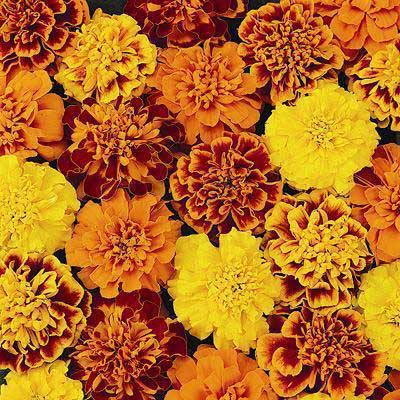
Marigold Seeds
Marigold plants are beautiful and easy to grow throughout the United States. They come in a multiple of colors, but orange being the most prevalent. Marigolds are easily grown from seeds in your flower garden. Marigolds can be grown inside 6-9 weeks before your last frost to get a jump start on the season. Starting indoors will ensure high germination and plant success. This also helps with proper spacing without the need to thin seedlings if directly sowed. After sowing seeds in soil, cover lightly with 1/8 inch of moist soil. Be sure to water generously once after sowing. Seeds will germinate and grow quickly once sprouted. Give your Marigold plants at least six to eight inches apart for dwarf varieties and a good 12 to 24 inches apart for Giant Marigolds. Marigolds love full sun and rich, well-drained soil. Add general purpose fertilizer once a month.
Learn More: How to Grow Marigolds
Suggested Varieties: Petite Mix – A dependable flower for short season gardens.
Crackjack – Large blooms on tall stems with vibrant colors.
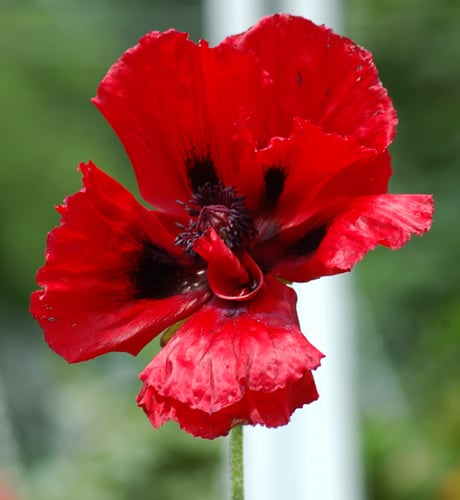
Poppy Seeds
Poppy flowers are another flower garden favorite that grabs attention and are fairly easy to propagate and care for. Poppies come in a variety of colors and sizes so find varieties that work best for your flower garden. Poppies can be started indoors or out, but it depends when you want your flowers to bloom. Higher germination rates can be achieved with indoor sowing. Most poppy seeds should be sowed at 1/8 inch deep but some need light to germinate so be sure to read directions. Once sowed, it is important to keep the soil moist, but not soggy. It will take 10-15 days for your poppy seeds to germinate. Once they become seedlings begin to water every few days until transplant size. Space your poppy plants 6-8 inches apart for adequate spacing and growing room. When poppies die o you can de-head them and save the seeds for the next growing seasons. You can also let them fall when ready and you will have poppies early the next season! They will need to be thinned as natural sowing does not offer exact spacing.
Learn More: How to Grow Poppies
Suggested Varieties:
Great Red – The most known, giant red poppy flower.
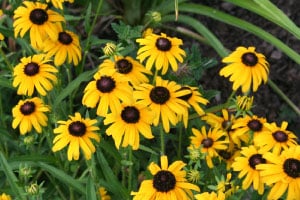
Rudbeckia Tips (Black Eyed Susan)
The Rudbeckiaflower can be grown in almost every state. These bright yellow, daisy-like flowers can grow 24-36 inches high and are excellent to use for indoor flower arrangements. These flowers can be started indoors or out. It is best to start indoors 6-8 weeks before the last frost date of your location. Cover with 1/4 inch of moist soil and water occasionally. When starting or transplanting outside, choose a location that receives full sun. Rudbeckias are very hardy and can survive in almost any soil conditions. If direct sowing into yourflower garden, sow 2 weeks before the last frost date. The best way to extend theflower blooms is to remove the dead flowers which will help direct more nutrient to healthy blooms. Most Reudbeckias are perennials that will come back every year. Be sure to plant where they have adequate room to grow for years.
Learn More: How to Grow Rudbeckia
Suggested Varieties:
Goldstrum – A popular variety with bright yellow petals and black center.
Black Eyed Susan – A beautiful, upright flower that grabs your eye.
Indian Summer – A variety that produces golden-yellow single and semi-double large blooms.
Annual Flowers
| Variety | Indoor Sowing Date | Days to Max Germination | Soil Temperature (℉) | Planting Depth | Weeks to Transplant |
|---|---|---|---|---|---|
| Ageratum | December-March | 7 | 75-78 | 1/8 inch | 8-10 |
| Alyssum | December-March | 8 | 78-82 | 1/6 inch | 10-12 |
| Amaranthus | December-March | 14 | 68-70 | 1/2 inch | 7-9 |
| Aster | January-April | 8 | 70-75 | 1/8 inch | 8 |
| Bachelor Button | February-March | 8 | 68-70 | 1/4 inch | 4-6 |
| Baby’s Breath | February-March | 8 | 68-72 | 1/4 inch | 6-8 |
| Celosia | January-April | 10 | 70-80 | 1/8 inch | 6 |
| Coleus | December-March | 10 | 70-75 | 1/4 inch | 6-9 |
| Cosmos | January-April | 5 | 68-72 | 1/4 inch | 6 |
| Daisies | February- March | 8 | 70-75 | 1/4 inch | 5-6 |
| Geraniums | November-February | 4-10 | 70-75 | 1/2 inch | 14-16 |
| Impatiens | December-March | 15 | 68-72 | 1/8 inch | 10-12 |
| Marigolds | January-April | 7 | 70-80 | 1/8 inch | 6-9 |
| Moon Flower | February-March | 8 | 70-75 | 1/4 inch | 6-8 |
| Morning Glory | February-March | 8 | 70-75 | 1/4 inch | 4-5 |
| Nasturtium | February-March | 8 | 70-74 | 1/2 inch | 6 |
| Pansy | November-February | 16 | 55-65 | 1/8 inch | 6-10 |
| Petunia | December-March | 10 | 70-80 | top | 10 |
| Salvia | December-March | 15 | 75-78 | 1/10 inch | 9 |
| Sunflower | February-March | 6 | 70-80 | 1 | N/A |
| Sweet Pea | February-March | 8 | 70-75 | 1 | 4-6 |
| Vinca | December-March | 15 | 70-80 | 1/4 inch | 12 |
| Zinnias | January-April | 7 | 68-72 | 1/8 inch | 5-8 |
Perennial Flowers
| Variety | Planting Depth | Indoor Sowing Date | Outdoor Sowing Date | Soil Temperature (℉) | Height (inches) | Spread (inches) | Soil | Light |
|---|---|---|---|---|---|---|---|---|
| Achillea | 1/8 inch | 6-8 | Early | 60 | 24-36 | 18 | Average, well-drained | Full |
| Black Eyed Susan | 1/4 inch | N/A | Anytime | 60 | 24-36 | 18 | Average | Full |
| Blanket Flower | 1/8 inch | 6 | 1-4 after | 70 | 24-40 | 14-16 | Loose | Full |
| Butterfly Flower | 1/8 inch | 6-8 | 1-4 after | 70 | 24-36 | 18-20 | Sandy, well-drained | Partial |
| Candytuft | 1/8 inch | 6-8 | Early | 65 | 1-15 | 8-10 | Well-drained | Partial |
| Coneflower | 1/4 inch | N/A | Early | 70 | 24-42 | 12-18 | Well-drained | Full |
| Coreopsis | 1/8 inch | N/A | 1-4 after | 70 | 18-48 | 6 | Moist | Full/Partial |
| Dahlia | 1/8 inch | 6-8 | Early | 65 | 12-36 | 16-24 | Rich, fertile | Full |
| Daisies | 1/8 inch | N/A | Early | 60 | 12-36 | 8-20 | Rich, well-drained | Full |
| Delphinium | 1/8 inch | 6 | 1-4 after | 60 | 12-48 | 18 | Average | Full/Partial |
| Dianthus | 1/8 inch | 6-8 | Early | 70 | 18-24 | 10-12 | Rich, well-drained | Full |
| Foxglove | 1/8 inch | N/A | Early | 65 | 24-60 | 24 | Average | Full/Partial |
| Geraniums | 1/8 inch | 6-10 | 1-4 after | 70 | 6-36 | 6-20 | Any soil | Full/Partial |
| Hosta | 1/2 inch | 6-10 | Early | 70 | 24-40 | 24-40 | Well-drained | Partial |
| Hollyhock | 1/8 inch | 6-8 | Early | 65 | 48-72 | 18-24 | Rich, well-drained | Full/Partial |
| Lupine | 1/8 inch | N/A | 2-4 after | 70 | 24-36 | 12-14 | Average | Full/Partial |
| Penstemon | Top | 6-8 | 2-6 | 70 | 12-36 | 18 | Loose | Full |
| Phlox | 1/8 inch | 6-8 | Early | 60 | 6-18 | 8-10 | Rich, loose | Full |
| Poppy | 3/8 inch | 6-8 | Anytime | 60 | 24-30 | 8-18 | Any soil | Full/Partial |
| Primrose | 1/8 inch | N/A | Early | 60 | 8-15 | 12-18 | Rich, moist | Full/Partial |
| Rudbeckia | 1/4 inch | N/A | Anytime | 60 | 24-36 | 12-24 | Average | Full |
| Tansy | 1/4 inch | N/A | Early | 65 | 36-48 | 6 | Average | Full/Partial |
| Viola | 1/8 inch | 6-8 | Early | 65 | 4-8 | 6 | Average | Partial |
